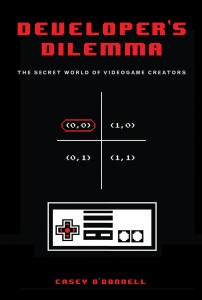Below is an excerpt from Casey O’Donnell’s book, Developer’s Dilemma: The Secret World of Videogame Creators (MIT Press, 2014).
– How to Play (Use) This Game (Book) –
The structure of this book is performative. It imitates the level structure of the Nintendo Entertainment System game Super Mario Bros. (SMB) to highlight the importance that games and how an understanding of games does work in game developer culture. This sense of a shared history and experience provides foundations for how videogame developers talk about their occupations. This is not really any different from any other discipline or environment of cultural production where experiences and language become entangled in ways that prevent broader accessibility. To make the work experiences of developers decipherable, the book is structured in a way that provides readers with the tools to help debug game developer culture.
- WORLD X—Each World in this book is a “chapter” in the traditional sense.
- WORLD X-1–X-4—Each World is a collection of four levels, much like SMB. Each level advances material that culminates in the Boss Fights found at the end of each world.
- BOSS FIGHT—Boss Fights, in games, require that players draw on new skills, lessons, or mechanics in order to progress to the next World. Think of it like a test. Bonus: I get to take the academic gloves off.
- #: SET DEBUG_MODE = 1—Most games have, lying underneath, a host of tools/options/data used during development that is invisible to the player. By turning “DEBUG_MODE” on (to 1 or TRUE), I am offering up some of the empirical data that lies behind the text.
- AUTHOR_DEV_DILEMMA—I use these sections, contained only in DEBUG_MODEs, to delineate my reflective comments. It is interpretation that b after the gathering of the data being presented. Time, experience, and analytic perspective offer something absent in just the transcripts.
- CASEY—My voice in interview transcripts contained only in DEBUG_ MODEs.
- TITLE_Project—Informant’s words in DEBUG_MODEs appear in a fashion that indicates their relative position within a company and the name or codename of the project they were working on at the time.
- #: SET DEMO Switch_MODE = 0—Turn DEMO Switch_MODE off (to 0 or FALSE)
– World 1-1: The Text’s Software Development Kit (SDK) –
…
While grounded in these different approaches to work practice, game theory, and new economy studies, this book differs from most other media that has covered the videogame industry. A small number of publications and online websites cater to game developers, offering new methods or reviews of development tools. Occasionally magazines like Wired, Newsweek, or Time will engage with the game industry, but infrequently with game studios. Journalists will swarm the most well-known executives or game designers, but never rank-and-file developers. Entire magazines are devoted to the latest videogames in development or recently released, and perhaps interview the games producer. The online enthusiast press observes all the meanderings of videogame corporations but offers very little analysis. Each of these perspectives is useful, and can frequently access information and people that I cannot. In this respect they have been invaluable resources.
However, this text is different in that the focal point remains on “typical” developers and work practice—the people who devote the majority of their time to bringing videogames into reality. This text is also executed with an eye to better understanding why they work in the ways they do. It is about observing the activities of everyday developers, who have largely disappeared behind the names of publishers or console manufacturers, and to better comprehending why things go right or wrong.
– World 1-2: The Characters—My Gorillas –
I never had any intention of studying the game industry. I just wanted to study how software development unfolds in practice. Then I stepped into the offices of Vicarious Visions (VV) in September 2004. For the most part, I was open to studying any software company. I had come expecting to study the lived reality of work practice in the context of the so-called new economy. And for my purposes, VV was ideal: a medium-sized, independent game development studio employing roughly seventy-five employees, a mixture largely of artists, engineers, designers, various managers, and support staff.
Throughout my fieldwork at VV, my informants did not know how to define my position. The inability to place me within existing understandings of what and who counted as legitimate members of the videogame development community was problematic for many of my informants. Often, this manifested in humorous ways, discussions of tribes, gorillas (silverbacks in particular), pith helmets, and mating rituals were common, representing their assumptions about cultural anthropology. Thinking of them this way is not intended to be derogatory, but is a means of expressing how the developers I spent so much time with came to understand the place of an anthropologist and fieldworker among them. It is also an expression of a continual kind of self-jesting that occurs among game developers. A tools engineer from VV actually presented me with a pith helmet at the conclusion of my dissertation defense, an object that now occupies a special place in my office. It, too, is indicative of the kind of creative and satirical humor entrenched in the game industry.
Other developers in the company feared I represented someone determining just how much time they were wasting or whether they were expendable. For such people I was a threat and was kept at arm’s length. A few simply could not comprehend what value might be found in observing their communities. Despite my best attempts to explain, they felt speaking with me would simply not be useful. To the remaining people, frequently those who became key informants, I represented a break or schism in a system they felt they could not critique. Somehow I had been authorized to ask the questions that they could not. I represented an opportunity to explicitly reconnect work experience to the political economy within which game development is nestled.
The timing of my arrival at VV was just right, because at the time, development had just begun on a game for Sony’s as-yet-unreleased handheld console videogaming system, PlayStation Portable (PSP). The game was based on a forthcoming movie from a major movie studio in partnership with one of the largest comic book companies (among other companies) and VV had been contracted for the project by one of the larger game publishing companies. It was presumed that the title would be developed and released simultaneously with the June 2005 release of the movie and shortly after the March release of the new game system. The project, code-named “Asylum,” was tasked with producing a series of prototypes and levels that would then be reviewed to determine if the rest of the development work would be entrusted to VV. Many small game studios that have proven their ability to bring a game to market will take on jobs like these either as the mainstay of their work or to fund other internal projects.
In January 2005, five months after I had begun my pilot research, Activision, Inc. (ATVI), one of the largest videogame publishers and a direct competitor of the publisher that had contracted the development of Asylum, bought VV. Most of my informants learned of the acquisition just hours prior to the press release; I was informed by the release itself.
I asked the lead designer on Asylum, who had aided me in getting access to VV, “What’s happening with Asylum and what’s happening with all of you?” The answers came back within hours: the acquisition by ATVI and the looming release of the PSP had convinced someone somewhere that Asylum would likely be unsuccessful, and the project had been shut down. ATVI was assigning everyone to a new project.
…
This text lays bare the work, rules, and other unspoken realities of the videogame industry in order to ask questions about those systems. Games are made by a wide ranging group of people, who at their core are driven by asking questions about and attempting to better understand underlying systems; and yet, they rarely do it of their own industry. Most disturbingly, these systems are becoming more opaque and reinforced in ways that most game developers ought to find abhorrent, given their proclivity and desire to get at these sorts of underlying systems. For so many, this is an activity that they are passionate about, and as such, all game developers need to ask if these rules and systems are functioning as they ought to and if they might rather see a different set of rules and systems in place.
There is a temptation, on the part of both cultural analysts and the general public to understand or equate videogame development with software development. Many educational programs even call themselves “game development” programs and focus only on the software development (often referred to as “software engineering” or “programming”) aspects of game development. Young people interested in videogames are often instructed by those unfamiliar with game development to enroll in computer science programs, where often they fail to find themselves at home. Game developers come in many flavors. Artists now constitute one of the largest segments of videogame development work. Game designers, while a smaller population than engineering teams, focus on issues very different from software development. Game development has always been a “strange mix” of artists, game designers, and engineers. To equate this milieu to software does a disservice to the work of the activity as well as the very particular technological, global, and political-economic context within which this labor occurs.
…
– World 1 Boss Fight: Ready? Fight! –
…
Burrowing into work practices within game development, this text will also explore how rising levels of interactivity go hand in hand with the decreasingly hierarchical or “flat” organization that has been touted as a distinguishing aspect of work in the new economy. Interactivity allows workers to experiment with the systems they both work within and create. Interactivity goes hand in hand with the connections between disciplines and cuts to the heart of what makes workers able to produce. This interactivity can also push too far, resulting in “infinite” meetings, emails, instant messages, and other forms of feedback and response. Interactivity can supplant the work, which then only gets done after hours.
This book hacks many of the disciplines that birthed it. Numerous disciplines—communications, social psychology, psychology, and media studies—have begun to stake out videogames as their new territories. Often, a single-minded approach on game spaces and content prevail. Games are seen simply as virtual environments to study within or for new media to study. The newly emerging discipline of game studies most explicitly suffers from this myopia, not stopping to wonder about the broader networks within which its newfound demand is being produced. This project proceeds with the assumption that videogames are media and technology, both of which are constructed within extensive networks that have largely been ignored. The secondary task of the project is to place work practice in a contextualized setting, such that it comes into connection with the structures that affect and shape it so dramatically.

